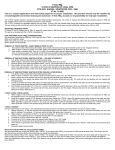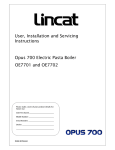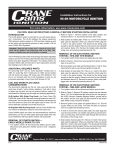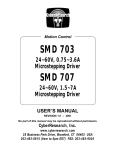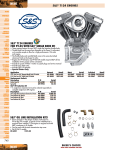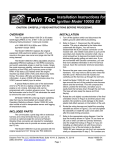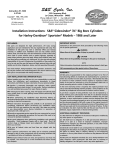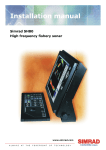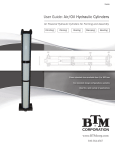Download Installation Instructions for HI-4N Motorcycle Ignition
Transcript
Instruction 510-0277 12-15-14 Copyright © 2014 by S&S® Cycle, Inc. S&S Cycle, Inc All rights reserved. Printed in the U.S.A. ® . 14025 Cty Hwy G PO Box 215 Viola, Wisconsin 54664 Phone: 608-627-1497 • Fax: 608-627-1488 Technical Service Phone: 608-627-TECH (8324) Technical Service Email: [email protected] Website: www.sscycle.com Installation Instructions for HI-4N Motorcycle Ignition DISCLAIMER: S&S parts are designed for high performance, closed course, racing applications and are intended for the very experienced rider only. The installation of S&S parts may void or adversely affect your factory warranty. In addition such installation and use may violate certain federal, state, and local laws, rules and ordinances as well as other laws when used on motor vehicles used on public highways, especially in states where pollution laws may apply. Always check federal, state, and local laws before modifying your motorcycle. It is the sole and exclusive responsibility of the user to determine the suitability of the product for his or her use, and the user shall assume all legal, personal injury risk and liability and all other obligations, duties, and risks associated therewith. The words Harley®, Harley-Davidson®, H-D®, Sportster®, Evolution®, and all H-D part numbers and model designations are used in reference only. S&S Cycle is not associated with Harley-Davidson, Inc. IMPORTANT NOTICE: Statements in this instruction sheet preceded by the following words are of special significance. WARNING Means there is the possibility of injury to yourself or others. CAUTION Means there is the possibility of damage to the part or motorcycle. NOTE Other information of particular importance has been placed in italic type. S&S recommends you take special notice of these items. WARRANTY: SAFE INSTALLATION AND OPERATION RULES: Before installing your new S&S part it is your responsibility to read and follow the installation and maintenance procedures in these instructions and follow the basic rules below for your personal safety. •• Gasoline is extremely flammable and explosive under certain conditions and toxic when breathed. Do not smoke. Perform installation in a well ventilated area away from open flames or sparks. •• If motorcycle has been running, wait until engine and exhaust pipes have cooled down to avoid getting burned before performing any installation steps. •• Before performing any installation steps disconnect battery to eliminate potential sparks and inadvertent engagement of starter while working on electrical components. •• Read instructions thoroughly and carefully so all procedures are completely understood before performing any installation steps. Contact S&S with any questions you may have if any steps are unclear or any abnormalities occur during installation or operation of motorcycle with a S&S part on it. •• Consult an appropriate service manual for your motorcycle for correct disassembly and reassembly procedures for any parts that need to be removed to facilitate installation. •• Use good judgment when performing installation and operating motorcycle. Good judgment begins with a clear head. Don’t let alcohol, drugs or fatigue impair your judgment. Start installation when you are fresh. •• Be sure all federal, state and local laws are obeyed with the installation. •• For optimum performance and safety and to minimize potential damage to carb or other components, use all mounting hardware that is provided and follow all installation instructions. •• Motorcycle exhaust fumes are toxic and poisonous and must not be breathed. Run motorcycle in a well ventilated area where fumes can dissipate. All S&S parts are guaranteed to the original purchaser to be free of manufacturing defects in materials and workmanship for a period of thirtysix (36) months from the date of purchase. Merchandise that fails to conform to these conditions will be repaired or replaced at S&S’s option if the parts are returned to us by the purchaser within the 36-month warranty period or within 10 days thereafter. In the event warranty service is required, the original purchaser must call or write S&S immediately with the problem. Some problems can be rectified by a telephone call and need no further course of action. A part that is suspect of being defective must not be replaced by a Dealer without prior authorization from S&S. If it is deemed necessary for S&S to make an evaluation to determine whether the part was defective, a return authorization number must be obtained from S&S. The parts must be packaged properly so as to not cause further damage and be returned prepaid to S&S with a copy of the original invoice of purchase and a detailed letter outlining the nature of the problem, how the part was used and the circumstances at the time of failure. If after an evaluation has been made by S&S and the part was found to be defective, repair, replacement or refund will be granted. ADDITIONAL WARRANTY PROVISIONS: (1) S&S shall have no obligation in the event an S&S part is modified by any other person or organization. (2) S&S shall have no obligation if an S&S part becomes defective in whole or in part as a result of improper installation, improper maintenance, improper use, abnormal operation, or any other misuse or mistreatment of the S&S part. (3) S&S shall not be liable for any consequential or incidental damages resulting from the failure of an S&S part, the breach of any warranties, the failure to deliver, delay in delivery, delivery in non-conforming condition, or for any other breach of contract or duty between S&S and a customer. (4) S&S parts are designed exclusively for use in Harley-Davidson® and other American v-twin motorcycles. S&S shall have no warranty or liability obligation if an S&S part is used in any other application. INTRODUCTION The HI-4N ignition system is intended for use on Harley-Davidson® motorcycles. The HI-4N replaces the original equipment (OE) point or electronic ignition system on 1970 - 1999 big twin (except Twin Cam 88®) and 1971 - 1990 Sportster® models. HI-4N Ignition With Stock-Style Dual Fire Coil. Dual fire mode (sometimes called Wasted Spark) is designed to use the stock ignition coil on most applications. Refer to Figure 1. HI-4N Dual Fire System Hookup IGNITION SWITCH The HI-4N is also perfect for S&S high performance engines. – +12V O.E. WHITE WIRE TO COIL + + IGNITION COIL WHITE 12 VOLT BATTERY NOTES • If cam cover on Sportster models has been replaced with a newer replacement part, the HI-4N may not fit due inadequate clearance in the ignition cavity. • HI-4N may be used with 1969 and earlier big twin models if a 12V electrical system, a special timer designed for 1970-’99 ignition system, and reverse timer gears have been installed. FRONT S&S/Viola V-Twin SPARK PLUG 550-0500 GROUND MODE SWITCH MUST BE SET TO 4, 5, 6, 7, OR 9 FOR DUAL FIRE APPLICATIONS REAR SPARK PLUG PINK MODE BROWN ADVANCE RATE WARNING X1000 RPM LIMIT X100 1996 and later models have a vehicle tilt sensor that shuts off the ignition if the motorcycle rolls on its side. This feature is disabled when the HI-4N ignition is installed. RPMX100 HI-4N IGNITION VIOLET TAPE UP UNUSED NOTE: BLUE WIRE If tach is not used, tape up brown wire. If VOES is not used, either tape up violet wire or connect to ground depending on application. The HI-4N features state-of-the-art technology that allows adjustable advance and rev limit. A timing LED indicates static timing (top dead center). Two starting modes are provided: electric start and kick start. A tach output gives accurate tach readings even at the rev limit. VOES (VACUUM SWITCH) Figure 1 ADDITIONAL REQUIRED PARTS FX series Big Twin® and XL series Sportster® models prior to 1984, FL series Big Twin® models prior to 1985, and all models with OE points will require OE Part # 32402-83 or S&S part # 55-1247 timing rotor. This part is not included with the HI-4N installation kit and must be purchased separately, HI-4N Ignition With Single Plug Heads. The prefered method is to use a single fire coil, which will fit in the stock mounting location on most H-D® motorcycles. Refer to Figure 2. HI-4N Single Fire System Hookup with Single Plug Heads IGNITION SWITCH COIL AND SPARK PLUG CABLE CONSIDERATIONS We recommend replacing the OE coil. Coils used with the HI-4N must have at least 2 ohms primary resistance. Coils with 4 ohms or higher may be used, but may not produce optimum output. O.E. WHITE WIRE TO COIL + +12V – + 12 VOLT BATTERY GROUND We recommend the following coils for single and dual-plug applications: MODE SWITCH MUST BE SET TO 0, 1, 2, 3, OR 8 FOR SINGLE FIRE APPLICATIONS For dual fire applications or single fire applications where two dual fire coils may be needed (Figure 3, dual plug heads) we recommend S&S/ Viola V-twin P/N: 550-0500. FRONT SPARK PLUG REAR SPARK PLUG PINK MODE ADVANCE RATE X1000 RPM LIMIT X100 For single fire applications with single plug heads, we recommend S&S part number 55-1571. HI-4N IGNITION WHITE S&S 55-1571 BLUE BROWN RPMX100 VIOLET The HI-4N is designed for use with suppression core, carbon or spiral core spark plug cables. Spiral core spark plug cables such as S&S/Viola V-twin P/N: 550-0524 are recommended for maximum performance. NOTE If tach is not used, tape up brown wire. If VOES is not used, tape violet wire or connect violet wire to ground depending on application. Do not use solid wire spark plug cables; they may cause interference with your ignition system and accessories. Figure 2 The figures that follow illustrate wiring connections for different applications and will be described in detail later in this instruction: 2 VOES (VACUUM SWITCH) HI-4N Ignition With Dual Plug Heads. Use two dual fire coils. You will have to fabricate a bracket to mount the second coil. Refer to Figure 3. enough to start the engine. Remove and save the two standoffs and washers. Remove the breaker plate assembly, wiring, cam, and advance assembly. HI-4 Single Fire System Hookup with Dual Plug Heads IGNITION SWITCH IGNITION COIL +12V – REMOVAL OF OE ELECTRONIC IGNITION SYSTEM—1978 & 1979 MODELS 1. Turn ignition switch off and disconnect battery ground cable. 2. Disconnect wires going from ignition module to coil. 3. Remove ignition cover plate and hardware. Save these items for later re-use. Remove ignition module. 4. Note location of timer plate. There is a V-notch (Figure 5) in the timer plate used for alignment. When you install the HI-4N, align the V-notch in the same location. This should set the timing close enough to start the engine. Remove and save the two standoffs and washers. Remove the sensor, shield, timer plate, trigger rotor, and advance assembly. S&S/Viola V-Twin 550-0500 O.E. WHITE WIRE TO COIL + FRONT COIL AND SPARK PLUGS + 12 VOLT BATTERY GROUND S&S/Viola V-Twin 550-0500 IGNITION COIL WHITE PINK MODE SWITCH MUST BE SET TO 0, 1, 2, 3, OR 8 FOR SINGLE FIRE APPLICATIONS REAR COIL AND SPARK PLUGS MODE BLUE ADVANCE RATE X1000 RPM LIMIT REMOVAL OF OE ELECTRONIC IGNITION SYSTEM—1980 & LATER MODELS 1. Turn ignition switch off and disconnect battery ground cable. 2. Remove OE ignition module and wire harness. You will disconnect two wires at the coil, wire going to the VOES (Vacuum Operated Electrical Switch), ground wire at the module, and the 3 pin plug that connects to the sensor plate. Refer to shop manual for locations. 3. Remove ignition cover plates and gasket. This will require drilling out two rivets. The rivets will later be replaced with two supplied self threading screws. 4. In order to remove the sensor plate cable, the cable plug must be removed first. Use needle nose pliers to pull the terminals out of the plug. Then pull the cable through the exit hole at the bottom of the timing cover. X100 BROWN HI-4N IGNITION RPMX100 VIOLET NOTE If tach is not used, tape up brown wire. If VOES is not used, tape up violet wire or connect to ground depending on application. VOES (VACUUM SWITCH) Figure 3 REMOVAL OF POINTS IGNITION — EARLY MODELS PRIOR TO 1978 1. Turn ignition switch off and disconnect battery ground cable. 2. Disconnect wire going from breaker points to Coil– (negative) terminal. 3. Remove ignition cover plate, and hardware. Save these items for later re-use. 4. Note location of breaker plate. There is a V-notch (Figure 5) in the breaker plate used for alignment. When you install the HI-4N, align the V-notch in the same location. This should set the timing close 10 1. Buttonhead Screws (2) 2. Outer Cover 9 3. Inner Cover Screws (2) 4. Inner Cover 7 8 6 HI-4N Unit Use Supplied Gasket Figure 4 3 5 5. Gasket 6. Sensor Plate Screws & Washers (2 each) 7. HI-4N Unit 8. Rotor Screw & Star Washer 9. Rotor 10. Gear Case Cover 4 2 3 1 5. Note location of sensor plate. There is a V-notch in the sensor plate used for alignment. See Figure 5. When you install the HI-4N, you should align the V notch in the same location. This should set the timing close enough to start the engine. Remove and save the two standoffs and washers. Remove the sensor plate. terminal. 3. For dual fire applications, connect the HI-4N pink wire to the Coil – (negative) terminal, and tape up the blue wire 4. For single fire applications, connect the pink wire to the terminal on the coil for the front cylinder, and connect the HI-4N blue wire to the Coil – terminal on the coil for the rear cylinder. 5. Connect the HI-4N brown wire to the tach wire, if equipped with a tachometer. Tape up if unused. 6. The HI-4N is grounded via the timing housing; a separate ground connection is not required. 7. Reconnect battery ground cable. Verify proper ground connections to the frame and engine. MODE ADVANCE RATE NOTE: Most motorcycle coils do not have terminals marked. Most single fire coils use the center terminal for +12V and the outer two terminals for front and rear cylinder Coil–. For dual fire coils use either terminal for Coil+ and the other one for Coil–. X1000 RPM LIMIT X100 VOES HOOKUP The OE vacuum operated electrical switch (VOES) is an open circuit when vacuum is below the setting of the switch. Lighter bikes generally have a VOES that opens at 3-5 inch-Hg, while the VOES used in heavier bikes such as touring models and on high performance engines. open at 6-7 in Hg. In low load operation when vacuum is above the VOES switch point, the VOES closes and grounds the vacuum input on the module. When this condition exists, the module uses the High Vacuum or Full Advance curve which provides more advance. When engine is under a load with throttle partially to fully open, manifold vacuum is reduced and the VOES opens the circuit, causing the module to switch to the Retarded Curve with less advance. This is designed to prevent knock on acceleration or under heavy loads, but allows full advance at cruising speeds, improving driveability and fuel economy. Connect the VOES to the HI- 4N violet wire as shown in Figures 1, 2, or 3. V-Notch Figure 5 HI-4N INSTALLATION 1. The HI-4N requires OE timing rotor Part # 32402-83, or S&S Part # 55-1247. For models prior to 1980, use the supplied 10-32 x 3/4” screw and washer to mount the rotor. Refer to Figure 4 for parts installation 2. Install HI-4N system in place of OE breaker or sensor plate. Rotate the HI-4N about 90˚ to give better access to the cable exit hole in the gear cover. On some early models it may be necessary to enlarge the cable exit hole. It is often easier to push the cable through the hole first, and tuck the cable into the cable indent in the base of the module when inserting the module into the gear cover. Align the V-notch on the HI-4N same as the OE plate you removed. Use the OE standoffs to secure the HI-4N. You may need to use lock washers under the standoffs for proper clearance between the HI-4N and cover plate. Do not fully tighten the standoffs until the timing has been set. 3. Route the HI-4N harness along the frame rails to the coil. Make sure that harness will not be chafed or burned by exhaust heat. Secure harness with tie wraps. Do not install timing cover at this time. NOTE: If you choose not to use the VOES, you may ground the violet wire, to force the module to use the Full Advance curves, or tape it up to use the Retarded Curves. Grounding the VOES wire in Race mode will effectively bypass the setting of the Advance Rate switch and cause the module to provide Maximum advance since there is only one Full Advance curve as shown in Figure 7. NOTE: 1996 and later models use a 2 wire connector between the VOES and the OE harness. Connect one wire from the VOES to frame ground and connect the other wire to the VOES input (violet wire) on the HI-4N. MODELS WITHOUT OE VACUUM SWITCH (VOES) This includes most models prior to 1985. Fuel economy and driveability will be improved if you install a VOES and connect it to the HI-4N violet wire as shown in Figures 1, 2, and 3. We recommend you use H-D® VOES P/N 26566-91 or S&S/Viola V-twin P/N 550-0399 for lighter bikes with stock to mild engines and S&S/Viola V-twin P/N 55-1248 for touring and high performance applications. If a VOES is not used, the violet wire may be grounded to use the Full Advance curve, or taped up to use the Retarded curve, depending on the application and timing requirements of the engine. HI-4N HOOKUP Crimp terminals and hardware are supplied for your convenience. Use the ring terminals for coil hookup. Use male-female quick disconnects for connections to the tach and vacuum switch (VOES). Tape up unused wires. Note: Damage will result if the brown tach wire comes in contact with +12V. HI-4N SETUP AND OPERATION Below is a description of the function for each switch. Refer to the Figure 5 to locate rotary switches for the following functions. 1. Identify switched +12 volt wire and tach wire (if equipped) going to the coil. Refer to your service manual, or reconnect the battery and use a test light or voltmeter. The switched +12 volt wire will be hot when the ignition key is turned on. 2. Refer to Figure 1, 2, or 3 depending on your application. Connect the HI-4N white wire and switched +12 volt wire to Coil + (positive) 4 NOTE - After changing switch settings, you must cycle ignition power (ignition switch ON – OFF –ON) for those changes to take effect. the OE curve ignition timing is too aggressive and cannot be adjusted to eliminate spark knock. MODE Switch Additional information regarding the ignition timing curves can be found in the section describing the ADVANCE RATE Switch. The MODE switch controls several aspects of the HI-4N’s operation. The table below briefly describes the operation in each mode: Kick Start and Electric Start Modes Kick Start modes fire on the first revolution of the engine for easier kick-starting. Electric start modes delay firing the spark plugs for 2 revolutions of the engine to reduce strain on the starter. MODE SWITCH SETTINGS 0 Single Fire, Single Spark, Race Curve, Electric Start 1 Single Fire, Single Spark, OE Curve, Electric Start 2 Single Fire, Multi Spark, Race Curve, Electric Start 3 Single Fire, Multi Spark, OE Curve, Electric Start 4 Dual Fire, Single Spark, Race Curve, Electric Start 5 Dual Fire, Single Spark, OE Curve, Electric Start 6 Dual Fire, Multi Spark, Race Curve, Electric Start 7 Dual Fire, Multi Spark, OE Curve, Electric Start 8 Single Fire, Single Spark, OE Curve, Kick Start 9 Dual Fire, Single Spark, OE Curve, Kick Start ADVANCE RATE Switch The ADVANCE RATE switch adjusts the “aggressiveness” of the curves with a setting of 0 being the least aggressive and a setting of 9 being the most aggressive. ADVANCE RATE switch settings between 0 and 9 select progressively more aggressive curves, with a setting of 4 or 5 being about halfway in between and 7 being about 75% of the way towards the MAX setting. Timing Considerations It is important that you understand the timing marks in your engine, as well as the timing required for your engine. Below are more detailed descriptions of each mode: Single Fire and Dual Fire Modes In Single Fire mode, each cylinder fires independently and only on the compression stroke (once every other revolution). The exception to this is when in Single Fire, Kick Start mode, the HI-4N fires both plugs at the same time during starting to reduce plug fouling. If you carry a passenger, pull a trailer, or are using low octane gasoline, a less aggressive advance curve may be required to reduce spark knock. More aggressive advance curves will give higher performance, but may require the use of high-octane gasoline to avoid spark knock. Figures 6 and 7 show the sets of timing curves that the HI-4N will run based on MODE and ADVANCE RATE switch settings: Dual fire mode (sometimes called Wasted Spark) is designed to use the stock ignition coil on most applications. In Dual Fire mode, the spark plugs for both cylinders fire at the same time when either cylinder is on the compression stroke (once per revolution). S&S HI-4N OE ADVANCE CURVE RANGE 40 Multi Spark and Single Spark Modes In the Multi Spark modes, the HI-4N delivers a series of sparks after the initial spark to reduce lean surge and plug fouling. Single Spark mode delivers one spark per ignition event. 35 ADVANCE DEGREES 30 Important! Do not attempt to use a timing light when the HI-4N is running in Multi Spark mode. Doing so could result in incorrect timing adjustment. Instead, set the MODE switch to the equivalent Single Spark mode when setting timing and then back to Multi Spark mode when finished. For example, if you want to run in mode 3 (Single Fire, Multi Spark, OE Curve, Electric Start), set the timing with the mode switch set to 1 (Single Fire, Single Spark, OE Curve, Electric Start), then switch back to mode 3 when you are finished. Again, be sure to cycle ignition power after changing switch settings for the change to take effect. 25 20 15 10 FULL ADVANCE CURVE - VOES CLOSED - POSITION 9 RETARDED CURVE - VOES OPEN - POSITON 9 FULL ADVANCE CURVE - VOES CLOSED - POSITION 0 5 RETARDED CURVE - VOES OPEN - POSITION 0 0 0 1000 2000 3000 4000 5000 6000 7000 8000 RPM Figure 6 Figure 6 shows the available range of Full Advance and Retarded curves available in OE Mode. Under low load conditions such as cruising at a steady speed on a level road, the throttle is not open very far and manifold vacuum will be higher than the switch point of the VOES. The switch will be closed, causing the module to use the Full Advance curve. When the load on the engine increases and the throttle is opened, vacuum is reduced below the VOES Switch point, causing the switch to open. The module will then switch to the Retarded Curve to prevent spark knock. OE and Race Timing Curves The HI-4N comes with the option to use one of two sets of ignition timing advance curves as described below: - OE curves for stock to mildly modified engines. - Race curves are for highly modified, high compression engines where Setting the Advance Rate switch to 0 (solid lines) will select the least aggressive pair of curves, and setting the switch to higher numbers will select from a series of progressively more aggressive curves that increase both the rate of advance and the total advance of the Full 5 Advance and Retarded curves. Setting 9 (dashed lines) will result in the most aggressive curves and maximum total advance. flywheels. Early Style includes most 1970-’80 includes most 1981-’95 models. models. Late Style Timing Marks For Harley-Davidson® Engines With Stock Flywheels Figure 7 shows the range of curves available in Race Mode. Note that the Full Advance curve is that same for all positions of the Advance Rate switch. 1970-'80 Models Front Cylinder TDC Mark S&S HI-4N RACE ADVANCE CURVE RANGE Early Style 1936-'80 40 35 ADVANCE DEGREES Front Cylinder 35° Advance Mark Front Cylinder TDC Mark 30 1981-'95 Models 25 20 15 10 FULL ADVANCE CURVE - VOES CLOSED - ALL POSITIONS RETARDED CURVE- VOES OPEN - POSITION 9 RETARDED CURVE - VOES OPEN - POSITION 0 5 Front Cylinder TDC Mark 0 0 1000 2000 3000 4000 5000 6000 7000 8000 Front Cylinder 35° Advance Mark Rear Cylinder 35° Advance Mark RPM Figure 7 1996-'99 Models (1995-'99 Export Models) The Retarded Curves in the Race Mode, which will be activated when the engine is under a load and manifold vacuum is lower than the VOES switch point, provide less aggressive advance rates and more retarded timing than the OE Mode. This allows tuners to accommodate large, high compression engines that do not need and generally cannot tolerate as much ignition advance under a load. Front Cylinder TDC Mark Setting the Advance Rate switch to 0 selects the least aggressive Retarded Curve, and setting the switch to higher numbers selects from a series of progressively more aggressive Retarded curves that increase both the rate of advance and the total advance of the Retarded curve. Setting 9 will result in the most aggressive curves and maximum total advance. Front Cylinder 35° Advance Mark Front Cylinder 20° Mark DO NOT USE Figure 8 Refer to Figure 9 for timing marks on S&S flywheels. The advance timing marks on S&S flywheels vary by application. Refer to the S&S flywheel timing mark charts for details The Year Code refers to letters contained in the flywheel identification code that is stamped on the side of the flywheel. This can also be observed through the timing inspection hole. RPM LIMIT (Rev Limit) Switches The RPM limit switches (RPM LIMIT) are adjustable from 1,500 to 7,500 RPM. Use a safe RPM limit for your engine. Do not set RPM limit below 1,500 or above 7,500. Timing Marks For Engines With S&S Flywheels The top, “X1000” switch adjusts the rev limit in 1000 RPM increments and the “X100” switch adjusts the rev limit in 100 RPM increments. The rev limit on the HI-4N shown in Figure 5 is set to 5500 RPM. Cylinder TDC Mark Cylinder TDC M T F Timing Marks The TDC and advance timing marks are located on the flywheel and can be observed though the timing inspection hole (refer to shop manual for details). Refer to Figure 8 for typical timing marks on stock Front Cylinder TDC Mark F Front Cylinder Advance Mark Figure 9 6 t Cylinder TDC M R RearCylinder Advance Mark S&S Flywheel Timing Marks for Harley-Davidson® Big Twin Models Year Code Engine Year/Description Advanced Timing Marks (deg BTDC) E 1936 – 1954 Big Twin 35° L 1955 – 1971 Big Twin 35° AL 1972 – Early 1981 Big 35° Twin SE 1955 – Early 1981 Big 35° Twin SL Late 1981 – 1999 Big 35° Twin SG S&S 4 1/8” Bore Big 30° Twin SM 1995 – 1999 EFI Big 35° Twin Verify that the front cylnder is on compression stroke by observing the position of the timing cup See Picture 1 for big twin or Picture 2 for Sportster® models. Refer to Figure 8 or 9 and find the diagram with a matching TDC mark. Use the corresponding advance mark shown in the diagram for setting timing as described in the dynamic timing procedure (setting timing using a timing light). S&S Flywheel Timing Marks for Harley-Davidson® Sportster® Models Year Code Engine Year/Description Advanced Timing Marks (deg BTDC) None 1957 – 1976 XL 40° B 1957 – Early 1981 XL 40° SB 1957 – Early 1981 XL 40° BD 1957 – Early 1981 XL 40° SBD 1957 – Early 1981 XL 40° SCD Late 1981 – 1985 XL 40° D Late 1986 – Up XL 30° KRS 45” WR/KR 30° Picture 1 NOTE: 1996 and later models (1995 and later for export models) have a timing mark at 20° BTDC for setting the timing with the OE ignition module. Do not use this mark for setting the timing on the HI-4N. In most cases an additional mark will remain at 35° BTDC (see Figure 8). Use this mark to set the timing with a timing light as described below. If unsure of which timing marks to use, remove spark plugs, turn engine while observing the marks that appear in the timing inspection hole. See Figure 10 As the front cylinder approaches TDC, the first mark to appear will be the front cylinder advance mark. Next you may be able to see the crankpin nut relief. the next mark to appear will be the TDC mark for the front cylinder. Picture 2 Timing The HI-4N Module NOTES • Do not attempt to use a timing light when the HI-4N is running in Multi Spark mode. Doing so could result in false timing adjustment. Instead, set the MODE switch to the equivalent Single Spark mode when setting timing and then back to Multi Spark mode when finished. For example, if you want to run in mode 3 (Single Fire, Multi Spark, OE Curve, Electric Start), set the timing with the mode switch set to 1 (Single Fire, Single Spark, OE Curve, Electric Start), then switch back to mode 3 when you are finished. Again, be sure to cycle ignition power after changing switch settings for the change to take effect. • Dynamic timing procedure will change settings made in the static timing procedure if the module is moved. • For applications where initial timing is critical, it is important to understand the range of ignition timing the HI-4N will produce based on MODE and ADVANCE RATE switch settings and what initial timing will result based on the dynamic timing procedure (setting timing using timing light). • If using a standard non-adjustable timing light, on an engine with a FLYWHEEL ROTATION FRONT CYLINDER TDC MARK FRONT CYLINDER ADVANCE MARK CRANKPIN NUT RELIEF Figure 10 7 • • • Initial Static Timing Procedure In most cases, aligning the V-Notch on the HI-4N plate to the same location as the OE plate will set the timing close enough to start the engine. See Figure 5. 35 deg advance timing mark, timing will correspond to the charts in Figures 6 and 7. On engines with different timing marks, such as Sportster® models and S&S 4 1/8” bore engines, the timing charts will be shifted based on the advanced timing mark location. For example, for 1200cc Sportster models with the advance timing mark at 40 deg BTDC, initial and advanced timing will be shifted 5 deg advanced. The timing inspection hole is about 10° wide. Placing a timing mark at the left edge of the hole will retard timing by approximately 5°, while placing a timing mark at the right edge of the hole will advance timing by 5°. Most dial back timing lights do not provide accurate timing with dual fire systems. Refer to your timing light’s instruction manual. If you are running in dual fire mode, set the timing light to 0 deg and time according to the procedure for a standard timing light. If after setting initial timing, you find that starting is poor, you can try advancing the initial timing. You can increase the advance by rotating the ignition clockwise as shown by the “ADV” marking and arrow on the ignition near the MODE switch. You can use the tic marks on the outside of the HI-4N mounting slots for timing reference. There is 10 deg between the large tic marks and 5 deg between the large and small tic marks See Figure 11. Most kick start applications work better with an initial timing of 8 deg BTDC. Electric start applications work well with an initial timing of 5 deg BTDC. Note that this will also increase the total advance timing by the same amount. If the engine will not start or runs very rough, you can use the following static timing procedure: 1) Be sure the ignition is off, remove the spark plugs, and turn the engine until the piston in the front cylinder is coming up on compression stroke. 2) Rotate the engine until the TDC (Top Dead Center) timing mark is centered in the inspection hole (See Figures 8 and 9 for timing marks or refer to your factory service manual). 3) Verify that the engine is indeed on TDC compression stroke. This can be verified by viewing the position of the rotor cup in the cam chest (For big twins see Picture 1. For Sportster Models see Picture 2) . 4) Ground spark plugs or spark plug wires with alligator clips to avoid electrical shock and possible damage to the coil. 5) Turn on the ignition, loosen the sensor plate screws holding the HI4N and rotate the unit clockwise until the timing LED goes off. In some instances, you may need to rotate the unit full counter-clockwise, then clockwise again for this to happen. The point at which the LED goes off is TDC. So, the initial timing is now at TDC. 6) Tighten the sensor plate screws, turn off ignition, and reinstall the spark plugs. 7) Engine can now be started and timing confirmed or adjusted with a timing light. Dynamic Timing Procedure (Setting Timing Using A Timing Light) 1) This timing procedure requires that a VOES be connected to the HI4N. For applications where a VOES is not used, ground the VOES input (HI-4N violet wire) to force the module to use the Full Advance curve while setting the timing with a timing light. 2) Connect a timing light to the front cylinder. 3) Set the HI-4N ADVANCE RATE switch to 9 (MAX Advance). 4) Run the engine at 2,500 RPM. 5) If using a standard non adjustable timing light, rotate the HI-4N module until the advance timing mark is centered in the observation hole. 6) If using an adjustable (dial back) timing light, set the light to the desired advance and rotate the HI-4N module until the TDC timing mark is centered in the observation hole. 7) Tighten the standoffs and verify timing has not shifted. 8) Be sure to put your MODE and ADVANCE RATE switch settings in the desired position after you have completed the dynamic timing procedure. 9) For 1200cc Sportster® models, it is recommended that the 40° advanced timing mark be centered in the timing hole with a standard timing light or the TDC mark be centered in the hole with an adjustable, dial back timing light set at 40°. 883cc engines should be timed to 40° by setting the advance timing mark to left side of the inspection hole using a standard timing light, or by centering the TDC mark with a dial back timing light set at 40°. 10) Refer to the following chart for recommended settings for S&S engines. 10˚ TIMING DIFFERENCE BETWEEN LARGE TIC MARKS 5˚ TIMING DIFFERENCE BETWEEN LARGE AND SMALL TIC MARKS Figure 11 Theses are recommended, initial settings only. Factors such as vehicle weight, fuel quality, and riding climate may affect settings. If detonation is encountered, you may need to retard timing further or performance may be improved by advancing timing. All complete S&S engines use S&S/Viola V-twin VOES P/N: 55-1248. 8 Recommended Settings for S&S Engines Engine C urve ADVANCE Advance Family RATE Timing Marks (deg BTDC) B ase Notes For Dynamic Timing Timing Offset SB100 Race 0° 0° 30° Dynamic time with OE curve, ADV RATE = 9, and VOES DISCONNECTED using timing mark V145 Race 5° 30° -5° Dynamic time with VOES grounded using timing mark V124 Race 0° 30° -1° Dynamic time with OE curve, ADV RATE = 0, and VOES GROUNDED using timing mark @ 3000 RPM V117 Race 0° 30° 0° Dynamic time with OE curve, ADV RATE = 9, and VOES DISCONNECTED using timing mark V113 Race 0° 35° -1° Use dial-back timing light and set at 34 deg BTDC w/VOES Grounded V111 Race 2° 30° 0° Dynamic time with OE curve, ADV RATE = 9, and VOES DISCONNECTED using timing mark V96 Race 0° 35° -3° Use dial-back timing light and set at 32 deg BTDC w/VOES Grounded V80 Race 5° 35° 0° Dynamic time with VOES grounded using timing mark SH80 OE 9° 35° 0° Dynamic time with VOES grounded using timing mark SH93 Race 2° 35° 0° Dynamic time with VOES grounded using timing mark SH93H Race 0° 35° 0° Dynamic time with VOES grounded using timing mark SH103 Race 0° 35° -2° Use dial-back timing light and set at 33 deg BTDC w/VOES Grounded P74 OE 9° 35° 0° Dynamic time with VOES grounded using timing mark P93 Race 2° 35° 0° Dynamic time with VOES grounded using timing mark P93H Race 0° 35° 0° Dynamic time with VOES grounded using timing mark P103H Race 0° 35° -2° Use dial-back timing light and set at 33 deg BTDC w/VOES Grounded KN74 OE 0° 35° 9° Use dial-back timing light and set at 40 deg BTDC w/VOES Grounded KN93 OE 0° 35° 9° Use dial-back timing light and set at 40 deg BTDC w/VOES Grounded Note: Reconnect VOES for normal operation. DISCONNECT or GROUND VOES wire only for timing purposes. Kick start modes only available with OE curves. If you are running a high compression, kick-start engine, start with ADVANCE RATE = 0, and retard ignition timing by rotating HI-4N counter clockwise if detonation occurs. the frame behind the seat. In order to provide a dedicated ground for the high starter current, another cable should be installed from the point on the frame that the battery is already grounded to the starter mounting flange. This cable should be the same diameter as the battery ground cable presently on the bike, and will help prevent damage to your electronic components. COVER PLATE ASSEMBLY You can re-use the OE hardware, and the supplied S&S gasket for the HI-4N. For models with a riveted outer cover, use the supplied selfthreading screws in place of the rivets. 1. Check that timing LED lights up and stays on when ignition key is first turned on. If not, check for +12 volts on white wire from HI-4N. 2. Check that timing LED blinks while engine is cranked. 3. If the timing LED blinks, but engine will not start, recheck all wire harness connections or replace coil(s). 4. Check for low voltage from a faulty or marginal charging system and battery. 5. If all of the above conditions have been checked, contact S&S Technical Support, 1-866-244-2673 for assistance TROUBLESHOOTING Did the engine run properly before installation of the HI-4N? If not, remove the HI-4N, reinstall the OE ignition or another known good unit and then find and correct the original problem. Did the HI-4N function correctly before the problem occurred? If the answer is yes, did you change anything that may have affected it? Try going back to the last setup that worked OK to help isolate the problem. CHECKING FOR SPARK To crank the engine and check for spark, use a KD Tools test plug or H-D® tool HD-26792. These test plugs come with an alligator clip that must be attached to frame or engine ground. Use a length of spark plug wire to connect the test plug to the coil. If the engine will not start, or runs rough or intermittently, use the following checklist steps: ENGINE WILL NOT START NOTE: The battery ground on most Harley-Davidsons® is connected to 9 WARNING Never crank the engine with any spark plug wire disconnected. MISFIRE OR INTERMITTENT OPERATION Field experience has shown that popping back through the carburetor, misfiring, and intermittent failure (especially after the engine gets hot) are usually not caused by electrical problems within the HI-4N. Carburetor problems, fouled spark plugs, coil failure, and loose wire harness connections are the most common culprits. Also, verify that spiral core or suppression type spark plug wires and resistor spark plugs are being used. TACH INOPERATIVE If the tach is inoperative after installation of the HI-4N, you may require a tach adapter. The HI-4N tach output is compatible with ground sensing tachs which includes most OE and aftermarket tachs. Some tachs require a high voltage trigger pulse. In this case, a tach adapter will need to be purchased separately. Note that the tach will read correctly at the rev limit only if it is connected to the brown wire from the HI-4N. Damage to the HI-4N circuitry may have occurred if 12 volts was applied to the brown tach wire at any time. 10










